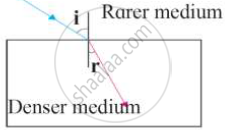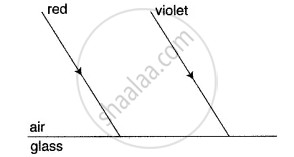Advertisements
Advertisements
Question
A student very cautiously traces the path of a ray through a glass slab for different values of the angle of incidence (∠i). He then measures the corresponding values of the angle of refraction (∠r) and the angle of emergence (∠e) for every value of the angle of incidence. On analysing these measurements of angles, his conclusion would be
(A) ∠i > ∠r > ∠e
(B) ∠i = ∠e > ∠r
(C) ∠i < ∠r < ∠e
(D) ∠i = ∠e < ∠r
Solution
Since the emergent ray is always parallel to the incident ray, therefore the angle of incidence is always equal to the angle of emergence i.e.
∠i = ∠e ..... (i)
Also, when a light ray travels from rarer to denser medium, it bends towards the normal. Hence
∠i > ∠r ..... (ii)
From (i) and (ii), we get
∠i = ∠e > ∠r
Hence, the correct answer is ∠i = ∠e > ∠r
APPEARS IN
RELATED QUESTIONS
Explain how the formation of a rainbow occurs.
Name a prism required for obtaining a spectrum of Ultraviolet light.
Draw the diagram of refraction of light in the glass slab
For which colour of white light, is the refractive index of a transparent medium the most?
Observe the figure and write accurate conclusion regarding refraction of light.

How does the deviation produced by a prism depend on the refraction index of its material.
What is meant by the refraction of light?
Two parallel rays of Red and Violet travelling through the air, meet the air-glass boundary as shown in the above figure. Will their paths inside the glass be parallel? Give a reason for your answer.

Explain with the help of a diagram of how fish is able to see the objects above it.
The refractive index of glass with respect to air is 3/2. What is the refractive index of air with respect to glass?
